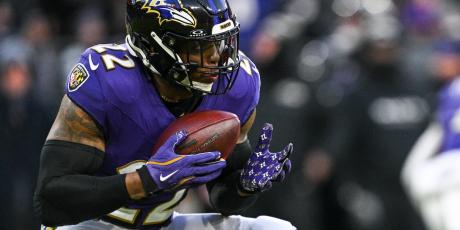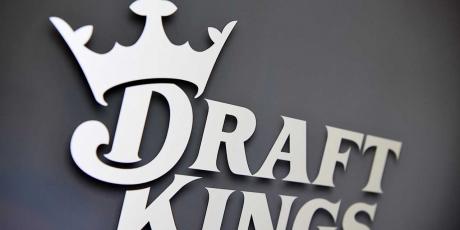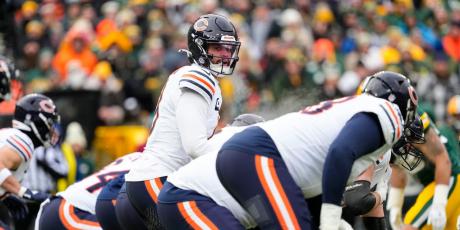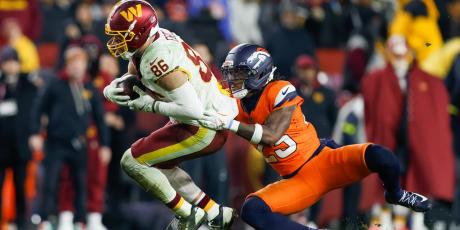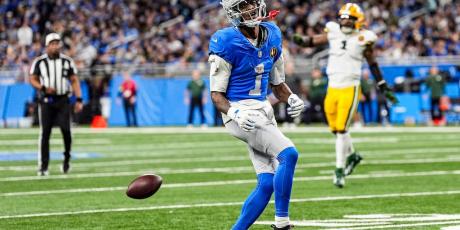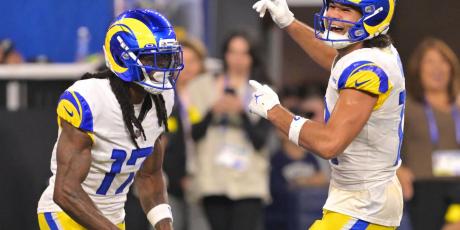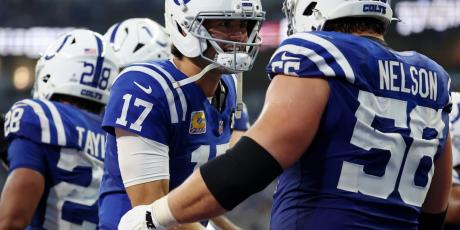The Most Predictable Running Back Stats
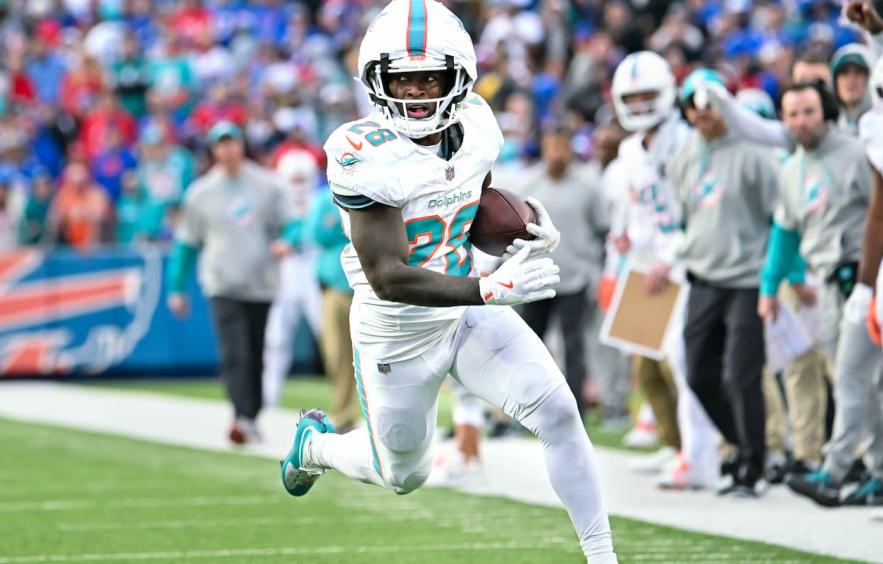
Last season was rough for data-based RB takes. For example, the teams that drafted RBs with the lowest elusive ratings from the 2023 season performed the best in Underdog’s Best Ball Mania V contest. But that’s mostly because Saquon Barkley had a below-average elusive rating during his last season with the Giants. You were similarly better off taking RBs with low PFF grades and rushing EPA per attempt. Let’s dig further into last season through rushing yards over expected before turning to model changes for the 2025 season.
More Predictable Stats: QB | WR | TE

DraftKings is giving ALL customers a can't-miss offer for Best Ball: Draft One, Get One! Enter a lineup in the $15 Million Best Ball Contest for just $20, and you'll score another Best Ball ticket to play FREE for a share of $15 million—giving you a second shot to win big!
Rushing Yards Over Expected
Unlike a lot of RB stats, rushing yards over expected (RYOE) from Next Gen Stats was useful last year. This is a continuation of a trend where drafters who focused on RBs with solid RYOE numbers, especially in the later rounds of the draft, tended to outperform their competitors. One strong word of caution about RYOE is for RBs who have changed NFL teams in the offseason. The graph below shows how RYOE changed for RBs when they switched NFL teams.
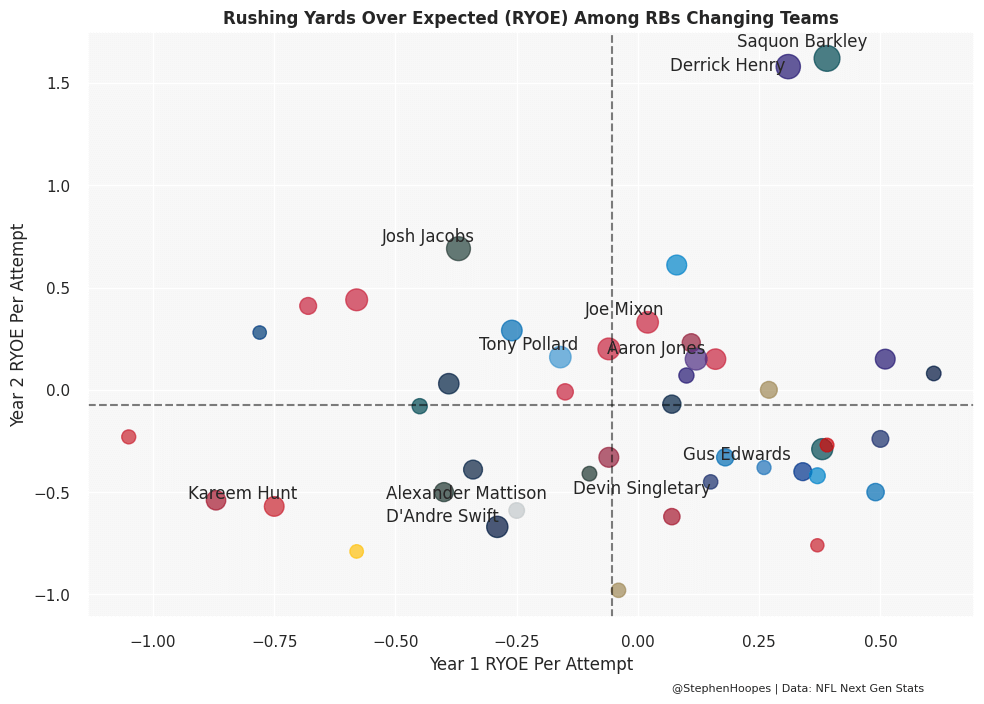
With the exception of Barkley and Derrick Henry as huge outliers, there’s no trend here. You’re better off looking at how well the RB’s new team did the prior year in RYOE. So, RYOE isn’t doing a great job of baking in team context, particularly run blocking. Because of that, we should be more willing to invest in free agent RBs with poor RYOE that land on teams with good RYOE. Unfortunately, there aren’t any obvious candidates for that this year, especially since I don’t believe Javonte Williams’ poor RYOE was the fault of the Broncos’ offensive line. But the general point is offensive line play and scheme are very important to RB production.
Modeling Process and Results
I expanded on this more in the QB article, but I’m taking a different approach this year. Instead of looking at each variable in a vacuum, I’m evaluating all variables at once. And one of those variables is market ADP. Additionally, I’m using weekly rather than seasonal data. To dig into the RB model specifically, let’s start by seeing how much each variable contributes to the model (aka its gain). That’s what the graph below does. It lists each variable in the model and what percentage it contributes to the model.
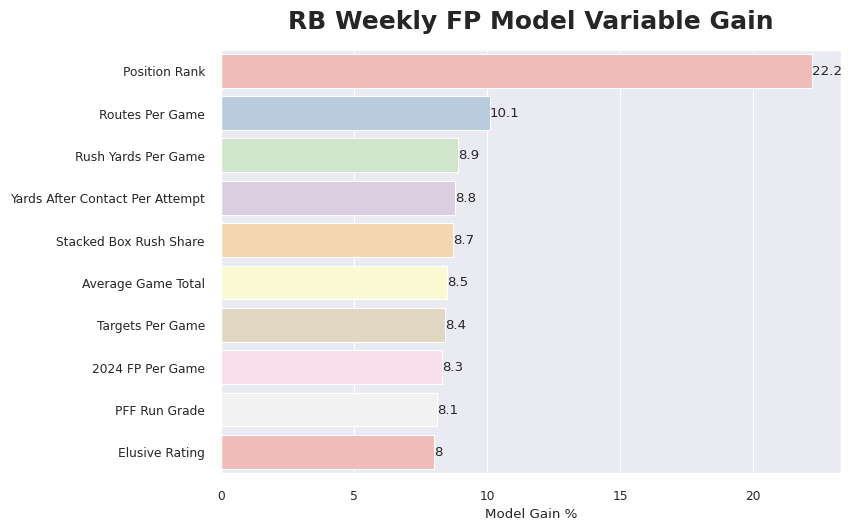
To look at how each individual variable works, we can use a partial dependence plot. These plots isolate the variable we’re looking at (in this case, position rank) and show how future fantasy points change as you move the position rank of the QB. Position rank is John Paulsen’s weekly rank going back to 2021.
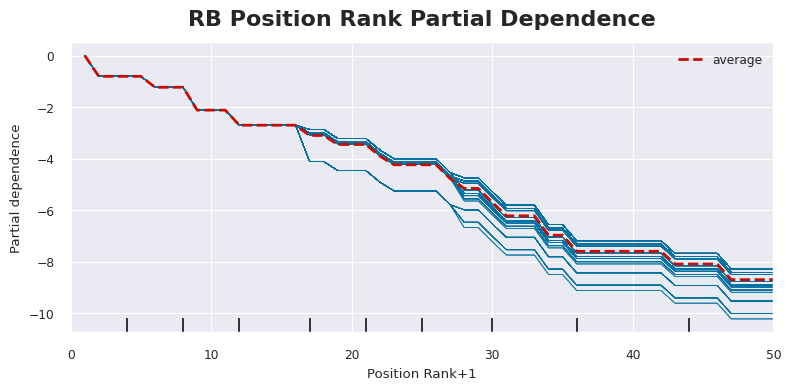
The overall trend is intuitive. As the projected rank of the RB increases (gets worse), their future fantasy points decrease. But focusing on the red average line below, you see these big dips after ranks eight and 17. That means historically, we have more confidence that RBs ranked in the top eight will perform at an elite level, and then RBs ranked after 17 have higher downside risk.
One interesting variable that popped up is the share of carries where the RB faced a stacked box. By a stacked box, I just mean eight or more defenders near the line of scrimmage on the play. Counterintuitively, the model expects a small boost in future fantasy points when an RB’s stacked box rate is over 24%. My first thought was that this was really a talent variable. If a defense feels the need to stack the box against an opposing RB, that RB is probably pretty good. After digging deeper, I think the model really just wants every RB to be Derrick Henry. Don’t we all.
The graph below shows the relationship between an RB’s season-to-date stacked box rate and their fantasy points the next week. In general, you want your RB to avoid the extremes. You don’t start getting the true spike weeks until an RB has a stacked box rate of at least 10%. And the spike weeks are starting to trail off in a big way around the 40% mark. That all makes sense. You want your RB to be good enough that the opposing defense sees them as a threat. But you don’t want your RB to be in an environment where the defense feels they can stack the box without consequences from the pass game.
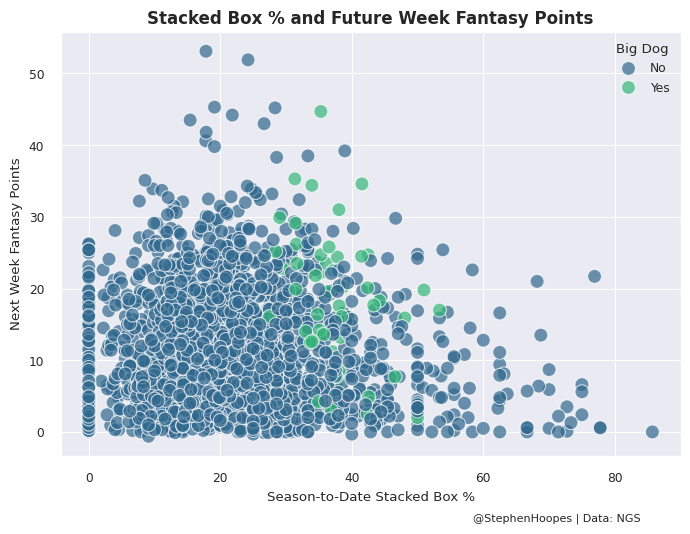
Let’s dig further into Derrick Henry specifically. The graph below shows only Derrick Henry’s weekly performances. The blue dots are from the 2021-2023 seasons, while the green dots are from last year. What you’ll notice is that all of his games from last season are on the left side of the graph. To me, that’s the Lamar Jackson effect. Jackson is such a dynamic passing and rushing threat that opposing defenses are unwilling to stack the box against Henry in the same way they did when he was on the Titans.
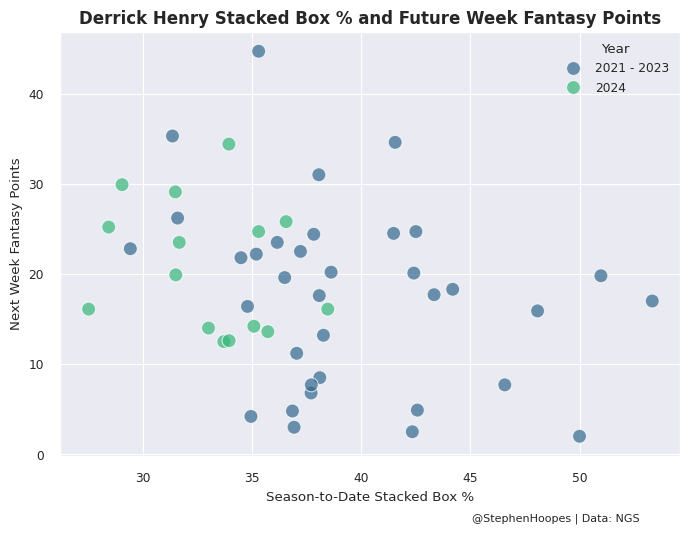
Since at least 2021, Derrick Henry has not scored fewer than 11 half-PPR fantasy points when he went into the game with a stacked box rate under 35%. And last season was the first year since 2020 when he averaged a stacked box rate under 35%. This ties directly back into the RYOE discussion from earlier. RB talent matters a lot, but so does the overall offensive environment and scheme. It’s one of my biggest lessons from last year.
2025 RB Predictions
So, what does the 2025 veteran RB landscape look like? The table below sorts them by their projected fantasy points per game using the above methodology. And I’ve highlighted in green the stats where an RB exceeded a key benchmark and in red when they failed to hit a key value. The number of routes that an RB runs per game is the most important piece of context on top of their position rank. And we also see targets per game as an important variable in the model as well. That means the market is not fully baking in the importance of receiving for RBs even in half-PPR formats.
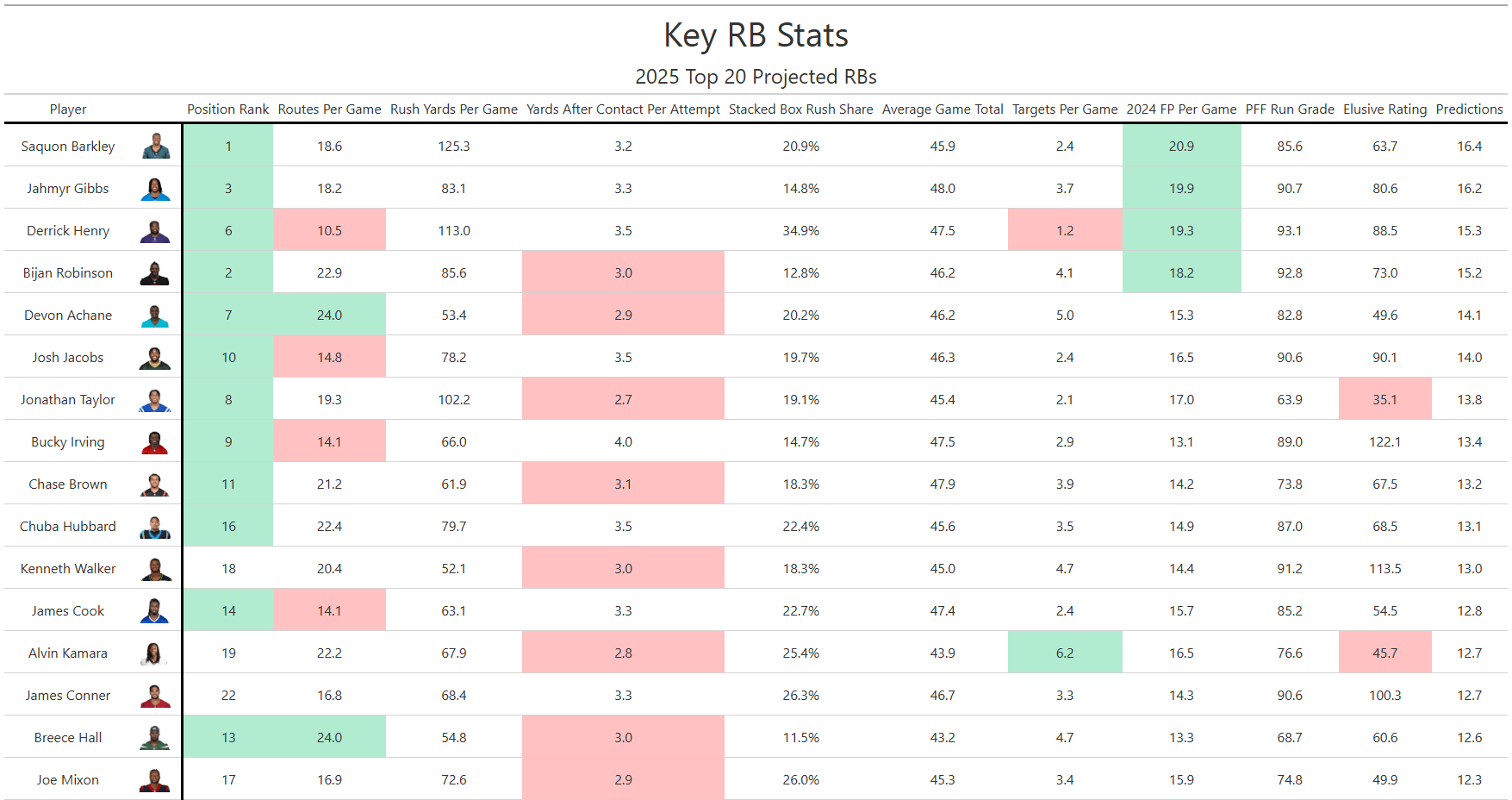

And that makes De'Von Achane my favorite RB bet in Round 2. He ran the most routes per game in the league last year and was second in targets per game behind Alvin Kamara. His rushing efficiency cratered last season, dropping to a concerning 2.9 yards after contact per attempt. In my opinion, a lot of that can be blamed on the interior of the Dolphins’ offensive line and injuries to Tua Tagovailoa. There’s at least some hope for the interior offensive line with the selection of Jonah Savaiinaea in the second round of the draft (though it’s still probably a problem). But the health of Tagovailoa will remain critical. According to PFF, Achane averaged 22.5 fantasy points per game with Tagovailoa playing and only 8.7 without him. And that was largely due to a target share split of 25.4% with Tagovailoa and 10.4% without him.
One RB the model flags is Kyren Williams. The routes are there, but the targets unfortunately aren’t. Only D'Andre Swift had worse yards after contact per attempt among the top-30 RBs. And he similarly had one of the lower elusive ratings among top RBs. So, he’s not very efficient rushing and isn’t earning receiving volume.
The bet then is that he continues to be among the leading RBs in snap and carry share. And that probably is the most likely outcome. But why do the Rams keep selecting RBs in the draft? And while Blake Corum was a Williams clone, Jarquez Hunter is a different profile. He hit a breakaway run on 48% of his attempts during his final season at Auburn, only a few percentage points below Ashton Jeanty. The model sees the Williams bet as thin.
Bottom Line
- This year, I’m incorporating ADP in order to find variables that provide additional context beyond existing market assumptions.
- 4for4’s weekly position ranking is the most important variable when predicting future week fantasy points.
- The market is not fully baking in the importance of receiving for RBs, with both routes and targets per game providing important context.
- Offensive line play and scheme are crucial to our assumptions, as shown through rushing yards over expected being much less useful for RBs changing NFL teams.
- Trends with stacked box rate are counterintuitive and largely caused by Derrick Henry’s insanity.


